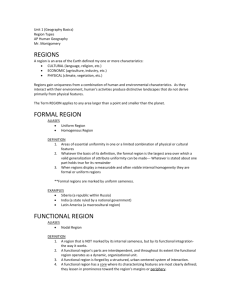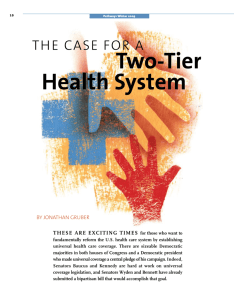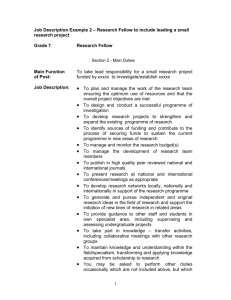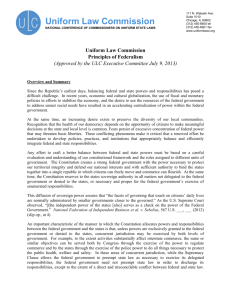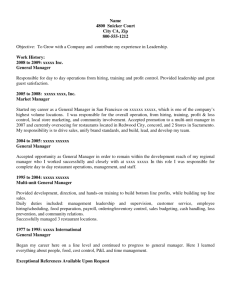Chapter 9
advertisement
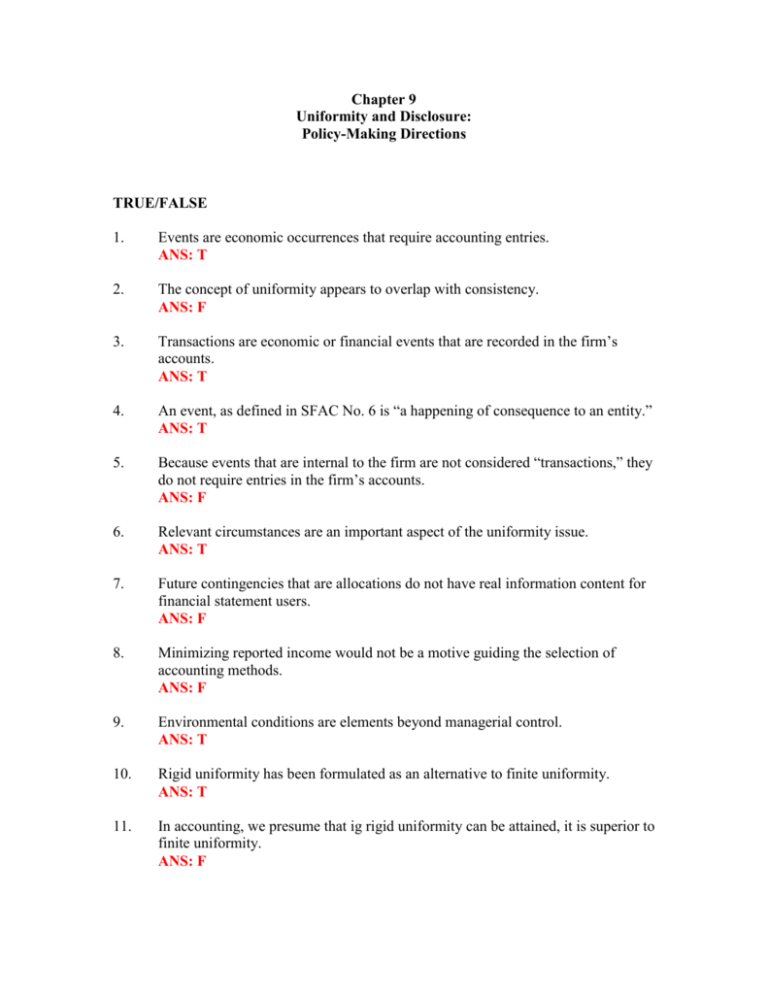
Chapter 9 Uniformity and Disclosure: Policy-Making Directions TRUE/FALSE 1. Events are economic occurrences that require accounting entries. ANS: T 2. The concept of uniformity appears to overlap with consistency. ANS: F 3. Transactions are economic or financial events that are recorded in the firm’s accounts. ANS: T 4. An event, as defined in SFAC No. 6 is “a happening of consequence to an entity.” ANS: T 5. Because events that are internal to the firm are not considered “transactions,” they do not require entries in the firm’s accounts. ANS: F 6. Relevant circumstances are an important aspect of the uniformity issue. ANS: T 7. Future contingencies that are allocations do not have real information content for financial statement users. ANS: F 8. Minimizing reported income would not be a motive guiding the selection of accounting methods. ANS: F 9. Environmental conditions are elements beyond managerial control. ANS: T 10. Rigid uniformity has been formulated as an alternative to finite uniformity. ANS: T 11. In accounting, we presume that ig rigid uniformity can be attained, it is superior to finite uniformity. ANS: F 12. Improving comparability may lessen relevance or reliability. ANS: T 13. Rigid uniformity considers relevant circumstances. ANS: F 14. Flexibility is an approach to the uniformity problem. ANS: T 15. Flexibility applies to situations in which there are relevant circumstances and more than one possible accounting method exists. ANS: F 16. Flexibility is not often used in generally accepted accounting principles. ANS: F 17. Whenever possible, flexibility should be used in formulating accounting policy. ANS: F 18. Finite uniformity should always be used in accounting for complex events. ANS: F 19. Since the 1970s, the SEC appears to have shifted its emphasis toward informative disclosure rather than protective disclosure. ANS: T 20. Lev advocated restricting disclosures to “good news” items only. ANS: F 21. An organized disclosure policy that includes “bad news” is beneficial to all parties because uncertainty about the firm is reduced. ANS: T 22. The SEC requires disclosure of both retrospective and prospective information in the Management’s Discussion and Analysis section of the annual report. ANS: T 23. Signalling theory appears to be inconsistent with the advocacy of greater disclosure. ANS: F 24. Management disclosures in the face of a major earnings surprise may take the form of conference calls with analyst or public announcements via news services. ANS: T MULTIPLE CHOICE 1. Which of the following is not a true statement? a. Comparability refers to accounting for similar transactions similarly and different circumstances differently. b. Comparability refers to comparing alternatives in order to make a decision. c. Comparability is an inherent quality of accounting numbers in the same sense that relevance and reliability are. XXXXX d. Uniformity influences comparability. 2. Which of the following is a true statement? a. Transactions are events that may be either external or internal to an enterprise. b. Events that are internal to the firm do not require entries in the firm’s accounts. c. Transactions are economic or financial events that may or may not be recorded in the firm’s accounts. d. “Simple events” do not have any significant economic variables that lead to essentially different recording. XXXXX 3. The term “present magnitudes” refers to: a. Conditions known at the time of an event XXXXX b. Conditions known only at a later date c. Events that will significantly affect the financial statements d. None of the above 4. Which of the following terms represent the two general types of relevant circumstances? a. Present circumstances and future contingencies b. Present conditions and future contingencies c. Present magnitudes and future conditions d. Present magnitudes and future contingencies XXXXX 5. Circumstantial variables are environmental conditions that posses which of the following qualities? a. Excessive measurement costs XXXXX b. A high degree of verifiability relative to other accounting methods c. Both a and b d. None of the above 6. Prescribing one method for generally similar transactions even though relevant circumstance may be present is referred to as: a. Finite uniformity b. Rigid uniformity XXXXX c. Inflexible uniformity d. Measurable uniformity 7. Which of the following is a true statement? a. Finite uniformity should be more representationally faithful than rigid uniformity. XXXXX b. Finite uniformity should be more verifiable than rigid uniformity. c. Rigid uniformity is more relevant than finite uniformity. d. Rigid uniformity can be obtained only at a greater cost than finite uniformity. 8. Where rigid uniformity is in effect, the underlying reasons may be attributable to all but which one of the following factors? a. A desire for conservatism b. An inability of the standard-setting organization to determine meaningful relevant circumstances c. An attempt to increase representational faithfulness of the measurement XXXXX d. Recognition of the fact that an allocation is involved 9. Flexibility applies to which of the following situations? a. Situations in which there are relevant circumstances and more than one possible accounting method exists b. Situations in which there are relevant circumstances but only one possible accounting method exists c. Situations in which there are no observable relevant circumstances and more than one possible accounting method exists XXXXX d. All of the above 10. The requirement by SFAS No. 2 that research and development costs be immediately expensed is an example of: a. Elastic uniformity b. Finite uniformity c. Flexible uniformity d. Rigid uniformity XXXXX 11. The determination of whether a lease is a capital or operating lease is an example of: a. Elastic uniformity b. Finite uniformity XXXXX c. Flexible uniformity d. Rigid uniformity 12. The treatment of loss contingencies required in SFAS No. 5 is an example of: a. Elastic uniformity b. Conservatism XXXXX c. Flexible uniformity d. Rigid uniformity 13. Accounting for inventory and cost of goods sold and for depreciation is an example of: a. Elastic uniformity b. Finite uniformity c. Flexibility XXXXX d. Rigid uniformity 14. Under which of the following circumstances should rigid uniformity be used? a. If the event is not a simple event b. If the event is a complex event in which finite uniformity cannot be instituted in a cost-effect manner. XXXXX c. Both a and b d. None of the above, rigid uniformity should never be used. 15. Under which of the following circumstances should finite uniformity be used? a. If the event is a simple event b. If the event is a complex event in which relevant circumstances cannot be measured and implemented in a cost-effective manner. c. If the event is a complex event in which relevant circumstances can be measured and implemented in a cost-effective manner. XXXXX d. Both a and b 16. Which of the following is a true statement? a. Disclosure is concerned with information in the financial statements as well as information in the footnotes, management’s discussion and analysis, financial and operating forecasts, and other supplementary communications. XXXXX b. Disclosure is concerned with information in the financial statements only. c. Disclosure is concerned with information in the footnotes only. d. Disclosure is concerned with information in the financial statements and all supplementary communications except financial and operating forecasts. 17. SFAC No. 5 defines disclosure as: a. Presentation of information in the financial statements b. Presentation of information by means other than recognition in the financial statements XXXXX c. Recognition of information in the financial statements of footnotes d. Presentation of information in any source available 18. Protective disclosure and informative disclosure are two types of disclosure as interpreted by the: a. FTC b. FASB c. AICPA d. SEC XXXXX 19. The system of disclosure largely in effect today is called: a. Selective disclosure b. Conventional disclosure c. Differential disclosure XXXXX d. Standard disclosure 20. The 10-K report filed annually with the SEC is basically aimed toward which of the following groups? a. Shareholders b. Professional financial analysts XXXXX c. Management d. All of the above 21. Which of the following describes information overload? a. The inability of preparers to process and adequately report all the information that should be provided in financial reports b. The inability of auditors to process and adequately attest to all the information that should be provided in financial reports c. The inability of users to process and intelligently use all the information provided in financial reports XXXXX d. The inability of preparers, auditors, and users to process and adequately utilize all the information provided in financial reports 22. In attempting to increase the importance of financial reporting the Jenkins Committee has placed the most emphasis on which of the following areas? a. Predictive uses XXXXX b. Accountability c. Comparability d. Consistency 23. The vehicle used by the Jenkins Committee for improving financial reporting is largely in which of the following areas? a. Educating financial statement users b. Improved and additional disclosures XXXXX c. Changing the format of the financial statements d. Accountability of auditors 24. Users questioned by the Jenkins Committee indicated that the single most important purpose the committee could accomplish was increasing the usefulness of: a. Pension disclosures b. Income tax disclosures c. Segmental disclosures XXXXX d. Comprehensive income disclosures 25. Which of the following represents the principal theoretical issue underlying quarterly data? a. Whether an interim period should be viewed as a separate period standing on its own XXXXX b. Whether an interim period report should include balance sheet and cash flow statements c. Whether quarterly earnings should be disaggregated by segments in terms of revenues, profit or loss, and segment assets. d. Whether interim reports should include income statement data and basic and fully diluted earnings per share numbers. 26. Which of the following is a recommendation of the Jenkins Committee? a. That the cash flow statement not be separated between core and non-core activities b. The retention of historical cost XXXXX c. Forecasted financial statements d. Eliminating the pooling method of accounting for business combinations 27. Viewing each interim period as a separate period standing on its own is called: a. The integral view b. The disjointed view c. The discrete view XXXXX d. The linked view 28. Which of the following represents the approach to interim reporting favored by APB Opinion No. 28? a. The integral view XXXXX b. Disjointed view c. The discrete view d. The linked view 29. From a theoretical standpoint, which of the following represents the approach to interim reporting with the most validity? a. The integral view XXXXX b. Disjointed view c. The discrete view d. The linked view ESSAY QUESTIONS 1. How does the concept of uniformity relate to comparability in the accounting literature? ANSWER: In the accounting literature, the concept of uniformity appears to overlap with comparability. According to Sprouse, the term comparability is used to mean accounting for similar transactions similarly and for different circumstances differently. He sees comparability as both the process of accounting for circumstances in accordance with similarities or differences and the end result of comparing alternative in order to make a decision. However, in the text, comparability is viewed only in the latter context, while uniformity is seen as the concept that influences comparability. The degree of comparability that users can rely on is directly dependent on the level of uniformity present in financial statements. 2. What is meant by relevant circumstances? Describe the two types of relevant circumstances. ANSWER: Relevant circumstances are economically significant circumstances that can affect broadly similar events. These economically significant circumstances are general conditions or factors associated with complex events that are expected to influence the incidence or timing of cash flows. Relevant circumstances pertain directly to the event being accounted for and influence the accounting method selected to represent that event. Those conditions known at the time of the event are referred to as present magnitudes. Factors that can be known only at a later date are called future contingencies. 3. Discuss the role of management in relevant circumstances. ANSWER: Managerial influence has been regarded as an important consideration in terms of allowing different accounting methods based on relevant circumstances. However there is a problem in that the selection of accounting methods might be guided by motives such as 1) 2) 3) Maximizing short-run reported income if managerial compensation is based on it. Minimizing short-run reported income if there is fear of governmental intervention on antitrust grounds. Smoothing income if it is believed that stockholders perceive the firm as having a lower amount of risk than would be the case if greater fluctuations of earnings were present. Because management is potentially capable of distorting income measurements, limiting relevant circumstance to elements beyond managerial control has been suggested. 4. Distinguish between finite uniformity, rigid uniformity and flexibility. Also, explain when each is appropriately used. ANSWER: Finite uniformity attempts to equate prescribed accounting methods with the relevant circumstances in generally similar situations. Rigid uniformity means prescribing one method for generally similar transactions even though relevant circumstance may be present. Finite uniformity should be more representationally faithful than rigid uniformity, but may be less verifiable. Rigid uniformity can improve comparability in situations where representational faithfulness is not the goal. However, improving comparability may destroy or weaken relevance or reliability. The presumption is that if finite uniformity can be attained, it is superior to rigid uniformity from the standpoint of usefulness in decision-making or performance evaluation. However, meaningful finite uniformity could be obtained only at a greater cost than rigid uniformity, so the advantage is merely relative and depends on marginal benefits and costs. Flexibility applies to situations in which there are no discernible relevant circumstances but more than one possible accounting method exists, any of which may be selected at the firm’s discretion. Whenever possible, flexibility should be eliminated. If it is possible to discern relevant circumstances and they can be measured and implemented in a cost- effective manner, finite uniformity should be implemented. If the event category is either a simple event or a complex event in which finite uniformity cannot be instituted in a cost-effective manner, rigid uniformity should be employed. 5. List the key disclosure recommendations in the Jenkins Committee Report. ANSWER: The key recommendations in the Jenkins Committee Report include: 1) Increase the usefulness of segment reporting by adopting a narrower segmentation in accordance with management’s own views. Important data on segments would include gross margin numbers, core activities, cash flows, and working capital requirements. Geographic information as well as primary industry segments should be provided. 2) Report core and non-core activities separately. Core activities are usual or recurring activities, whereas non-core activities are either unusual or nonrecurring activities (or both), such as interest income and interest expense. In addition, intra-statement income tax allocation would be employed with tax expense split between core and non-core activities. The core/non-core concept would also be extended to the balance sheet and the cash flow statement. 3) Issue separate fourth quarter interim financial statements and account for segments on a quarterly basis. 4) Secondary recommendation included: a) Improve disclosures for assets and liabilities with low verifiability by identifying how the measurements were derived as well as information about underlying assumptions and future events considered in the measurement. b) Disclose more information about innovative financial instruments and off-balance sheet financing arrangements. c) Users do not need forecasted financial statements, but they do need information that will enable them to make their own forecasts. d) The report expressed less concern with eliminating alternatives in similar event situations and more concern with providing disclosure about alternatives and methods selected. e) It discouraged valuing internally generated intangibles such as goodwill because of a low degree of verifiability and because their effect on future cash flows is difficult to determine. f) It also called for eliminating less relevant disclosures. Disclosures intended to educate users as new standards are introduced should be eliminated when users become familiar with the standard. 6. What is meant by differential disclosure? Identify the three differential disclosure proposals discussed in the text. ANSWER: Differential disclosure as it is in effect today refers to the fact that the 10-K and 10-Q reports filed annually and quarterly by management with SEC are basically aimed toward professional financial analysts. They are more detailed and technical than the annual report going to shareholders. Three additional differential disclosure proposals include: 1) Small firms versus larger firms: The FASB specifically considers implications of disclosures for smaller firms with the express purpose of requiring discloses only where they are relevant and cost effective. 2) Summary annual reports (SAR): These reports are condensed financial statements that omit or boil down much of the detail contained in the body of the traditional audited financial statement and are a new development in disclosures. Management discussion and analysis on the other hand is generally more expansive. The SAR is intended to replace the traditional corporate annual report and to be more understandable. The wide use of SARs would be a revolutionary development in financial reporting. 3) SEC attempts to streamline annual reports: The SEC has proposed that financial statements in annual reports be streamlined by reducing the number of footnotes. This proposal was abandoned shortly after it was introduced because investors thought they were being deprived of important information.
